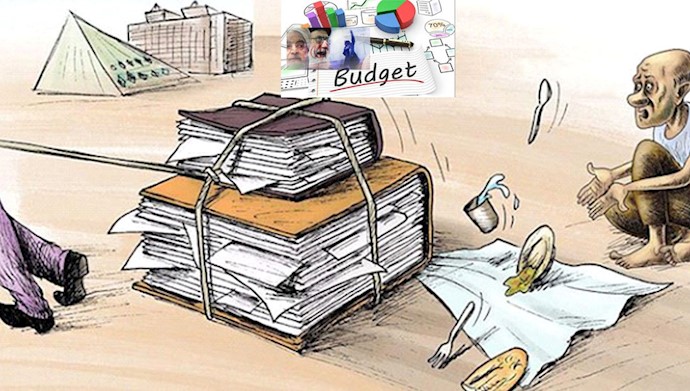Analysis by PMOI/MEK
Jan. 1, 2019 – On December 28, Iranian national broadcaster presented a report about the government budget for the next Persian year (March 2019-Mar 2020) and claimed that the problems of poor and unemployed people will be resolved, minimum wages will rise, the unemployed youth will be given jobs, and goods will become cheaper.
“In next year’s budget, the government intends to increase the wages of employees in tandem with increasing the employment rate for the youth, all the while keeping the prices for gas at the 10,000-rial [10 cents] level and make sure that supervision is made in a way that goods reach people with cheap prices,” the report said.
Generally, when you see too much praise and compliment, something is fishy. A balanced review always lists both the pros and cons of the phenomenon in question.
But before casting our judgment, let’s have a look at what other Iranian outlets and experts working with the Iranian regime right now have to say about Rouhani’s budget bill.
One of the things pundits point at with the budget bill is a lack of transparency.
“[Next year’s] budget is not transparent,” says Vahid Shaqaqi Shahri, an Iranian economist, to Fararou website.
One of the non-transparent fields is the “high budget deficit” which isn’t presented in the budget bill.
“In terms of income, the government is going to have more than $10 billion deficit,” which is a quarter of the whole budget, according to Shaqaqi Shahri.
He also points at a new trend in the Rouhani government to conceal the budget deficit through a mechanism called “future selling”.
“In the budget, there is a $4.4 billion income through the selling of financial and Islamic bonds… For three years, we’ve introduced the evil phenomenon of future selling of resources in the country,” He adds.
Farshad Momeni, another Iranian economist and advisor to former presidency candidate Mir Hossein Moussavi during the 2009 presidential elections, also points to the lack of transparency in the budget bill and describes its political nature saying: “In financial shortages, the government always moves towards less transparent budgets, and the overlap between the 2019/2020 budget and the political election cycle of the parliament can worsen this situation.”
Another problem with the budget bill is a lack of practical solutions to key problems.
Mohammad Javad Tavakoli writes: “As much as you study the president’s and his economic team’s speeches, you won’t find a clue about what plans they have to reform and change these structures. Apparently, you have to wait another five years for them to discover the remedy after they’ve discovered the disease.”
Truth is that Iran’s economic problems are deeply rooted and can’t be healed with hope-inducing speeches in front of the parliament and in national television.
The 2019/2020 budget bill leans heavily on oil income. Jahan-e Sanat, an Iranian newspaper close to Hassan Rouhani, writes: “A gloomy prospect is estimated for the oil market and in addition to the sanctions which will have an impact on Iran’s oil income, lower oil prices will leave less maneuver room for Iran.”
The budget bill assumes that Iran will export 1.5 million barrels per day for a $54 price per barrel and it turns out that both estimations are wrong.
State-run Mehr news agency writes: “In the budget bill which was sent to the parliament… three weeks ago, the government estimated that next [Iranian] year [That’s from March 2019 to March 2020] it will export 1.5 million barrels [per day] for $54 per barrel. That’s while, because of the oil ministry’s passivity over the last month, Iran’s oil exports have decreased dramatically and are less than one million barrel per day. This shows that the oil ministry couldn’t even efficiently use the waivers that have been given to six countries to buy oil from Iran.”
State-run Javan newspaper writes: “Next [Iranian] year will be one of the harshest budgetary situations for the country. Sanctions have led to a dramatic decrease in Iran’s oil export and since oil income has a key share in the budget, the organization of programming and budget and the government will face challenges and a lack of resources.”
Next year’s budget bill estimates a 20-percent increase in employees’ and pensioners’ income. But let’s face it, even if Rouhani realizes the 20-percent increase, the current inflation rate will increase living costs considerably more.
In addition, Rouhani claims to create more job opportunities for the youth, but even before the second round of U.S. sanction, the future looked gloomy for the Job market.
Back in August, before the second round of U.S. sanctions, Euronews website wrote: “The all-encompassing impact of the first wave of U.S. sanctions on Iran will be an inflation rate above 40 percent and unemployment of one million Iranians.”
Four decades of economic mismanagement, nepotism, kleptocracy, and rampant corruption have weakened the foundations of the Iranian economy beyond repair.
The second round of U.S. sanctions haven’t yet shown their full impact on the Iranian economy and it’s obvious that wishful thinking and propaganda won’t put food on Iranian tables.





